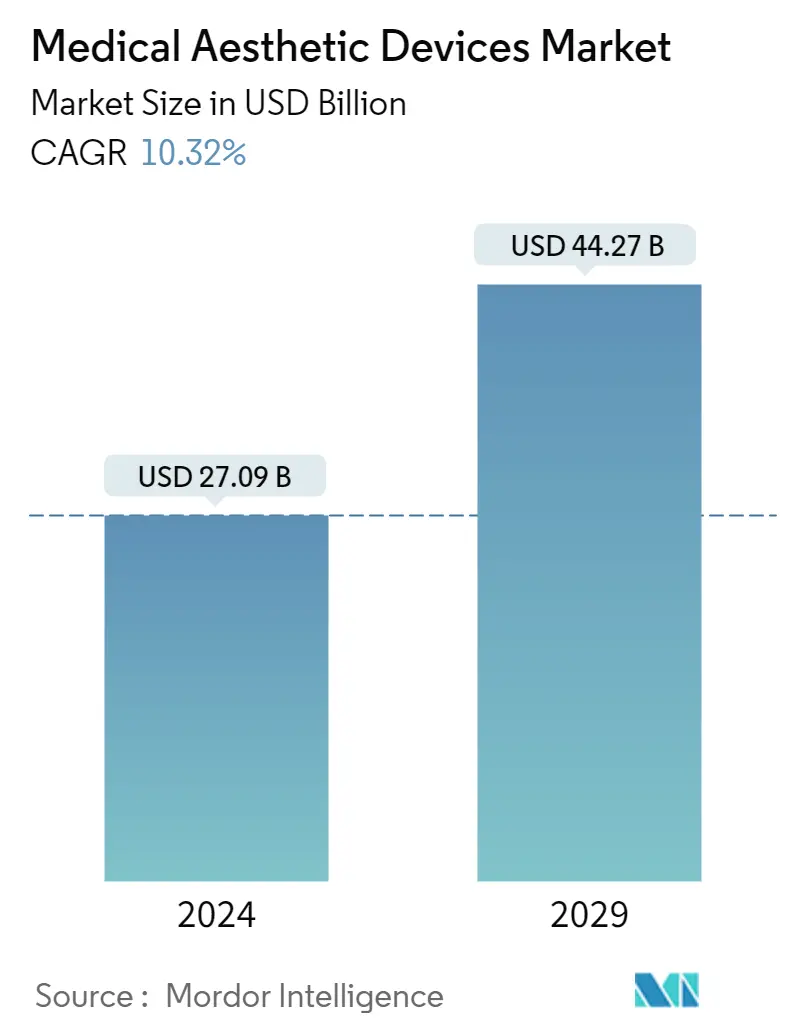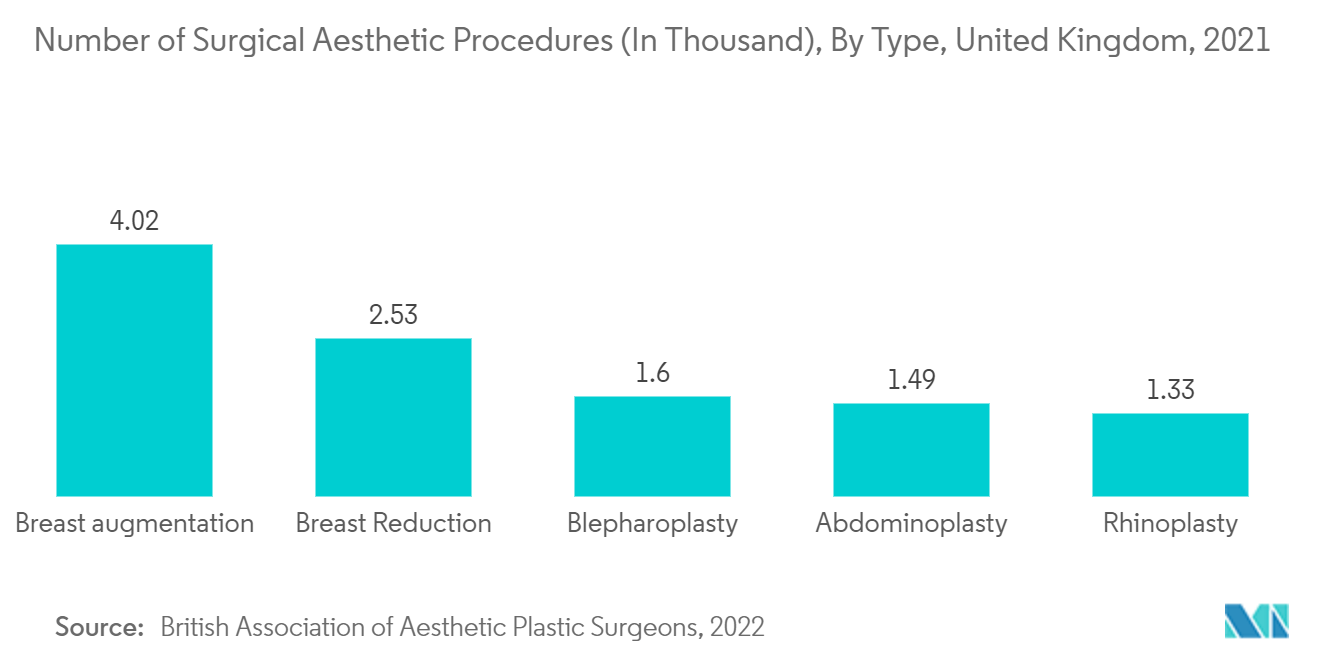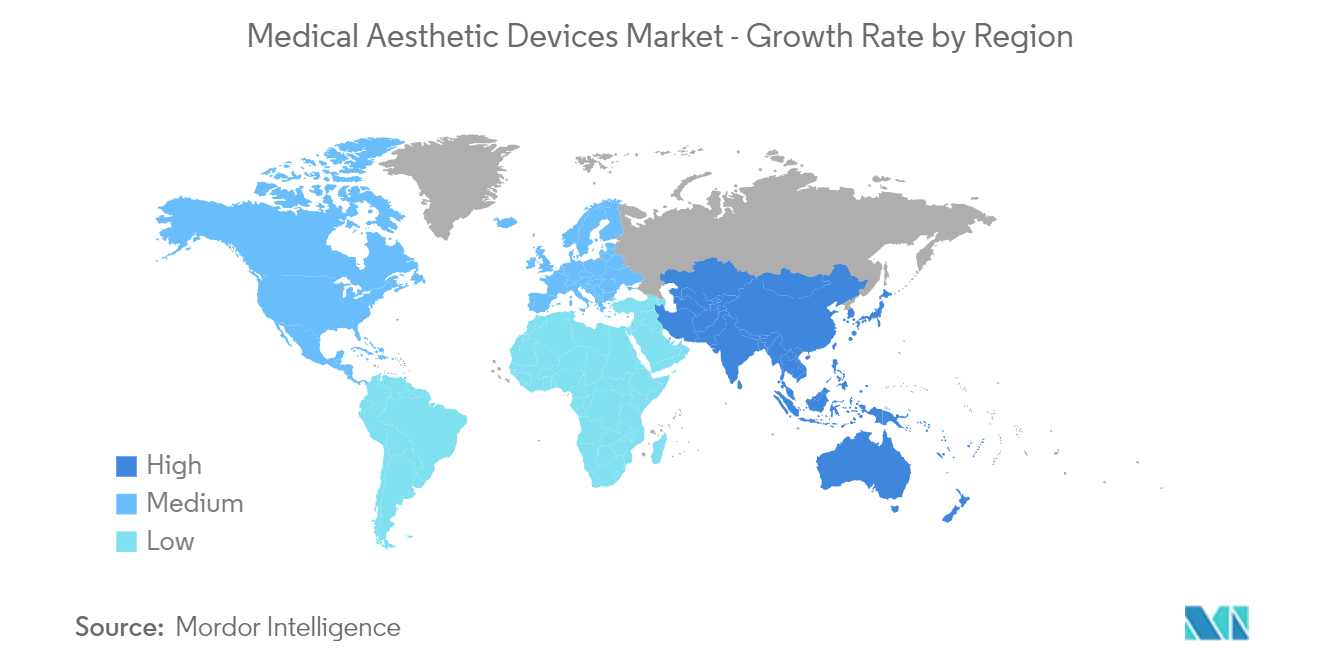Medical Aesthetics Market Size

| Study Period | 2019 - 2029 |
| Market Size (2024) | USD 27.09 Billion |
| Market Size (2029) | USD 44.27 Billion |
| CAGR (2024 - 2029) | 10.32 % |
| Fastest Growing Market | Asia Pacific |
| Largest Market | North America |
Major Players
*Disclaimer: Major Players sorted in no particular order |
Medical Aesthetics Market Analysis
The Medical Aesthetic Devices Market size is estimated at USD 27.09 billion in 2024, and is expected to reach USD 44.27 billion by 2029, growing at a CAGR of 10.32% during the forecast period (2024-2029).
The COVID-19 pandemic significantly impacted the growth of the medical aesthetic devices market in early 2020 due to the lockdown imposed and many aesthetic procedures being canceled. An article published in the Journal of Clinics in Dermatology in June 2021 indicated that various procedures, such as deep peeling and laser treatments, were avoided during the COVID-19 pandemic because of the disruptions in the skin barrier. Also, the procedures, such as high-intensity focused ultrasound, fractional radiofrequency, and cryolipolysis equipped with stainless steel, gold, or plastic handpieces and probes, were postponed due to the risk of contamination.
However, aesthetic devices that consumers could use in their homes increased after the COVID-19 pandemic. According to an article published in the International Journal of Trichology in February 2022, home-based aesthetic devices have increased in recent years. They became more relevant during the COVID-19 pandemic, as more patients were hesitant to visit clinics for non-emergency reasons.
Major factors such as the increasing obese population, awareness regarding the aesthetic procedure, rising adoption of minimally invasive devices, and technological advancement in aesthetic devices are propelling the growth of the market.
The increasing volume of aesthetic procedures worldwide is also contributing to the market's growth. For instance, according to the ISAPS survey released in December 2021, 10,129,528 surgical procedures and 14,400,347 nonsurgical cosmetic procedures were performed around the globe in 2020. Furthermore, according to the BAAPS survey released in February 2021, 15,405 cosmetic surgical procedures were performed in the United Kingdom in 2021. The increasing number of aesthetic procedures requires medical aesthetic devices. This is creating the need for medical aesthetic devices and driving the market's growth.
Also, the growing adoption of minimally invasive and non-invasive aesthetic procedures drives the market studied. As per an article published in the Journal Archives of Plastic Surgery in November 2021, the demand for aesthetic procedures was on the rise all over the world, especially in East Asian countries. With the advent of the internet, information became accessible to everyone, and people started becoming more aware of aesthetic procedures. All these factors together increased the public's awareness of medical aesthetic procedures, which, in turn, increased the sales of medical aesthetic devices. This is resulting in a huge growth in the market size of medical aesthetic devices.
Additionally, the approval of products by various regulatory authorities is also boosting the market's growth. For instance, in January 2022, Lumenis launched the Splendor X device, CE cleared for hair removal, vascular treatments, pigmented lesions, and wrinkles in the United Kingdom.
Thus, owing to the abovementioned factors, the market studied is expected to grow during the forecast period. However, social stigma and poor reimbursement scenarios may hinder the market's growth.
Medical Aesthetics Market Trends
This section covers the major market trends shaping the Medical Aesthetic Devices Market according to our research experts:
Botulinum Toxin is Expected to Witness the Significant Growth During the Forecast Period
Botulinum toxin is a neurotoxic protein produced by the bacterium clostridium botulinum. The botulinum toxin injections tend to block the nerve signals to the muscle in which it is injected. As the muscle cannot contract without a signal, it diminishes or decreases unwanted facial wrinkles or appearance. As a result, highly diluted concentrations of botulinum toxin are used for cosmetic and non-cosmetic purposes, such as for treating frown lines between the eyebrows, dystonia, chronic migraine, and other purposes.
Factors like the popularity of botulinum toxin procedures among young adults, the rise in demand for minimally invasive cosmetic methods, a higher number of beauty-conscious populations, and the launch of products are propelling the growth of the market segment.
The American Society of Plastic Surgeons survey was released in June 2022 in the United States. It reported that botulinum toxin Type A is one of the top minimally invasive cosmetic procedures among patients during 2021-2022. It also reported that patients aged 31- 45 year most commonly seek botulinum toxin type A cosmetic procedures. Additionally, an ISAPS survey released in December 2021 revealed that among all the non-surgical cosmetic procedures performed globally in 2020, 43.2% were Botulinum Toxin procedures. It also reported that a total of 6,213,859 botulinum toxin procedures were performed. Such a high adoption of botulinum toxin procedures creates more demand for it and thus drives the growth of the market segment.
The major players in the market are also investing more in the import and export of botulinum toxin products and are keenly investing in technological advancements. For example, in September 2022, Revance Therapeutics Inc. received approval from USFDA approved DAXXIFY (DaxibotulinumtoxinA-lanm) for injection for the temporary improvement of moderate to severe frown lines (glabellar lines) in adults.
Thus, owing to the abovementioned factors, the botulinum toxin segments are expected to project significant growth during the forecast period.

North America Holds Significant Share and Expected to do the Same During the Forecast Period
North America's medical aesthetic devices market is expected to project significant growth owing to the increasing volume of different aesthetic procedures, rising awareness about aesthetic and minimally invasive procedures, and technological advancement in the region.
The large volume of aesthetic procedures in the region creates the need for aesthetic devices and thus drives the growth of the market. According to the AAFPRS survey released in March 2022, an estimated 1.4 million surgical and non-surgical procedures were performed in the United States in 2021, an increase of 40% over the procedures performed in 2020. Additionally, according to the ISAPS survey released in December 2021, 860,718 aesthetic procedures were performed in Mexico in 2021, of which 456,489 were aesthetic surgical procedures and 404,229 were non-surgical aesthetic procedures. Thus, the increasing number of cosmetic procedures among the population is anticipated to boost the growth of the market during the forecast period.
Also, the high concentration of key players in the region and subsequent product launches play a vital role in the growth of the market in the region. For instance, in April 2021, Alma Lasers launched Alma PrimeX, the ultimate non-invasive platform for body contouring and skin tightening.
Additionally, strategic initiatives are taken by the market players to strengthen their position also boosts the growth of the market in the region. For instance, in November 2021, NanoPass Technologies and Aesthetic Management Partners (AMP) signed an agreement to commercialize NanoPass's MicronJet 600 intradermal delivery device in the United States.
Thus, the aforementioned factors are expected to boost the market during the forecast period in North America.

Medical Aesthetics Industry Overview
The medical aesthetic devices market is moderately competitive and consists of many players. Companies like Abbvie Inc. (Allergan PLC), Alma Lasers Ltd (Sisram Med), Bausch Health Companies Inc. (Solta Medical Inc.), Cutera Inc., El. En. (Asclepion Laser Technologies), Lumenis Inc., Sciton Inc., and Syneron Medical Ltd hold a substantial share in the market.
Medical Aesthetics Market Leaders
-
Cynosure
-
Abbvie Inc.(Allergan plc)
-
Alma Lasers (Sisram Med)
-
Bausch Health Companies Inc. (Solta Medical Inc.)
-
Johnson & Johnson Private Limited
*Disclaimer: Major Players sorted in no particular order

Medical Aesthetics Market News
- June 2022: Cynosure launched the PicoSure Pro device, its latest upgrade to the PicoSure platform. PicoSure Pro is one of the first 755nm picosecond lasers cleared by the US FDA.
- May 2022: GC Esthetics Inc. launched an innovative nipple-areola complex (NAC) reconstructive implant called FixNip NRI in Europe under an exclusive partnership agreement with FixNip LTD.
Medical Aesthetics Market Report - Table of Contents
1. INTRODUCTION
- 1.1 Study Assumptions and Market Definition
- 1.2 Scope of the Study
2. RESEARCH METHODOLOGY
3. EXECUTIVE SUMMARY
4. MARKET DYNAMICS
- 4.1 Market Overview
-
4.2 Market Drivers
- 4.2.1 Increasing Obese Population
- 4.2.2 Increasing Awareness Regarding Aesthetic Procedures and Rising Adoption of Minimally Invasive Devices
- 4.2.3 Technological Advancement in Aesthetics Devices
-
4.3 Market Restraints
- 4.3.1 Social Stigma Concerns
- 4.3.2 Poor Reimbursement Scenario
-
4.4 Porter's Five Forces Analysis
- 4.4.1 Threat of New Entrants
- 4.4.2 Bargaining Power of Buyers/Consumers
- 4.4.3 Bargaining Power of Suppliers
- 4.4.4 Threat of Substitute Products
- 4.4.5 Intensity of Competitive Rivalry
5. MARKET SEGMENTATION (Market Size by Value - USD million)
-
5.1 By Type of Device
- 5.1.1 Energy-based Aesthetic Device
- 5.1.1.1 Laser-based Aesthetic Device
- 5.1.1.2 Radiofrequency (RF)-based Aesthetic Device
- 5.1.1.3 Light-based Aesthetic Device
- 5.1.1.4 Ultrasound Aesthetic Device
- 5.1.2 Non-energy-based Aesthetic Device
- 5.1.2.1 Botulinum Toxin
- 5.1.2.2 Dermal Fillers and Aesthetic Threads
- 5.1.2.3 Microdermabrasion
- 5.1.2.4 Implants
- 5.1.2.4.1 Facial Implants
- 5.1.2.4.2 Breast Implants
- 5.1.2.4.3 Other Implants
- 5.1.2.5 Other Aesthetic Devices
-
5.2 By Application
- 5.2.1 Skin Resurfacing and Tightening
- 5.2.2 Body Contouring and Cellulite Reduction
- 5.2.3 Hair Removal
- 5.2.4 Facial Aesthetic Procedures
- 5.2.5 Breast Augmentation
- 5.2.6 Other Applications
-
5.3 By End User
- 5.3.1 Hospitals
- 5.3.2 Clinics
- 5.3.3 Home Settings
-
5.4 Geography
- 5.4.1 North America
- 5.4.1.1 United States
- 5.4.1.2 Canada
- 5.4.1.3 Mexico
- 5.4.2 Europe
- 5.4.2.1 Germany
- 5.4.2.2 United Kingdom
- 5.4.2.3 France
- 5.4.2.4 Italy
- 5.4.2.5 Spain
- 5.4.2.6 Rest of Europe
- 5.4.3 Asia-Pacific
- 5.4.3.1 China
- 5.4.3.2 Japan
- 5.4.3.3 India
- 5.4.3.4 Australia
- 5.4.3.5 South Korea
- 5.4.3.6 Rest of Asia-Pacific
- 5.4.4 Middle East and Africa
- 5.4.4.1 GCC
- 5.4.4.2 South Africa
- 5.4.4.3 Rest of Middle East and Africa
- 5.4.5 South America
- 5.4.5.1 Brazil
- 5.4.5.2 Argentina
- 5.4.5.3 Rest of South America
6. COMPANY PROFILES AND COMPETITIVE LANDSCAPE
-
6.1 Company Profiles
- 6.1.1 Abbvie Inc. (Allergan PLC)
- 6.1.2 Alma Lasers (Sisram Med)
- 6.1.3 Bausch Health Companies Inc. (Solta Medical Inc.)
- 6.1.4 Cutera
- 6.1.5 El.En. S.p.A. (Asclepion Laser Technologies)
- 6.1.6 Cynosure
- 6.1.7 Boston Scientific Corporation (Lumenis Inc.)
- 6.1.8 Sciton Inc.
- 6.1.9 Candela Corporation
- 6.1.10 Venus Concept
- 6.1.11 Johnson & Johnson Private Limited
- 6.1.12 Merz Pharma
- *List Not Exhaustive
7. MARKET OPPORTUNITIES AND FUTURE TRENDS
** Subject To AvailablityMedical Aesthetics Industry Segmentation
As per the scope of the report, medical aesthetic devices refer to all medical devices that are used for various cosmetic procedures, which include plastic surgery, unwanted hair removal, excess fat removal, anti-aging, aesthetic implants, skin tightening, etc., that are used for beautification, correction, and improvement of the body.
The medical aesthetic devices market is segmented by Type of Device (Energy-based Aesthetic Device (Laser-based Aesthetic Device, Radiofrequency (RF) Based Aesthetic Device, Light-based Aesthetic Device, and Ultrasound Aesthetic Device) and Non-energy-based Aesthetic Device (Botulinum Toxin, Dermal Fillers and Aesthetic Threads, Chemical Peels, Microdermabrasion, Implants (Facial Implants, Breast Implants, and Other Implants) and Other Aesthetic devices)), Application (Skin Resurfacing and Tightening, Body Contouring and Cellulite Reduction, Hair Removal, Facial Aesthetic Procedures, Breast Augmentation, and Other Applications), End-User (Hospitals, Clinics, and Home Settings), and Geography (North America, Europe, Asia-Pacific, Middle East, and Africa, and South America). The market report also covers the estimated market sizes and trends for 17 countries across major global regions. The report offers the value in USD million for the above segments.
| By Type of Device | Energy-based Aesthetic Device | Laser-based Aesthetic Device | |
| Radiofrequency (RF)-based Aesthetic Device | |||
| Light-based Aesthetic Device | |||
| Ultrasound Aesthetic Device | |||
| By Type of Device | Non-energy-based Aesthetic Device | Botulinum Toxin | |
| Dermal Fillers and Aesthetic Threads | |||
| Microdermabrasion | |||
| Implants | Facial Implants | ||
| Breast Implants | |||
| Other Implants | |||
| Other Aesthetic Devices | |||
| By Application | Skin Resurfacing and Tightening | ||
| Body Contouring and Cellulite Reduction | |||
| Hair Removal | |||
| Facial Aesthetic Procedures | |||
| Breast Augmentation | |||
| Other Applications | |||
| By End User | Hospitals | ||
| Clinics | |||
| Home Settings | |||
| Geography | North America | United States | |
| Canada | |||
| Mexico | |||
| Geography | Europe | Germany | |
| United Kingdom | |||
| France | |||
| Italy | |||
| Spain | |||
| Rest of Europe | |||
| Geography | Asia-Pacific | China | |
| Japan | |||
| India | |||
| Australia | |||
| South Korea | |||
| Rest of Asia-Pacific | |||
| Geography | Middle East and Africa | GCC | |
| South Africa | |||
| Rest of Middle East and Africa | |||
| Geography | South America | Brazil | |
| Argentina | |||
| Rest of South America |
Medical Aesthetics Market Research FAQs
How big is the Medical Aesthetic Devices Market?
The Medical Aesthetic Devices Market size is expected to reach USD 27.09 billion in 2024 and grow at a CAGR of 10.32% to reach USD 44.27 billion by 2029.
What is the current Medical Aesthetic Devices Market size?
In 2024, the Medical Aesthetic Devices Market size is expected to reach USD 27.09 billion.
Who are the key players in Medical Aesthetic Devices Market?
Cynosure, Abbvie Inc.(Allergan plc), Alma Lasers (Sisram Med), Bausch Health Companies Inc. (Solta Medical Inc.) and Johnson & Johnson Private Limited are the major companies operating in the Medical Aesthetic Devices Market.
Which is the fastest growing region in Medical Aesthetic Devices Market?
Asia Pacific is estimated to grow at the highest CAGR over the forecast period (2024-2029).
Which region has the biggest share in Medical Aesthetic Devices Market?
In 2024, the North America accounts for the largest market share in Medical Aesthetic Devices Market.
What years does this Medical Aesthetic Devices Market cover, and what was the market size in 2023?
In 2023, the Medical Aesthetic Devices Market size was estimated at USD 24.56 billion. The report covers the Medical Aesthetic Devices Market historical market size for years: 2019, 2020, 2021, 2022 and 2023. The report also forecasts the Medical Aesthetic Devices Market size for years: 2024, 2025, 2026, 2027, 2028 and 2029.
What are the latest trends in Medical Aesthetic Devices?
The latest trends in Medical Aesthetic Devices are a) Minimally invasive procedures b) Technological advancements c) Personalized treatments
Medical Aesthetics Industry Report
The medical aesthetic equipment market is segmented by type of device, application, end-user, and geography. The market is experiencing robust growth, driven by an increasing demand for non-invasive cosmetic procedures and substantial technological advancements. This market includes a variety of segments, notably energy-based and non-energy-based devices, focusing on body contouring, skin rejuvenation, and anti-aging treatments. Non-energy-based devices are favored for their minimally invasive nature, aligning with consumer preferences for low-downtime treatments.
Regionally, North America leads due to its advanced healthcare infrastructure and a culture that values aesthetic enhancement. The Asian markets are rapidly growing due to increased disposable incomes and greater consumer awareness of aesthetic options. Despite hurdles like high costs and strict regulations, ongoing innovation in the aesthetic technology space, including the development of portable and multifunctional devices, is set to drive further market expansion.
For an extensive medical aesthetic industry overview, including insights on aesthetic medical device companies and medical aesthetics market share, Mordor Intelligence™ offers detailed reports and forecasts. The market forecast indicates a positive trend in market growth, driven by market leaders who continue to innovate. The industry outlook remains optimistic as market trends show a steady increase in demand for both energy-based and non-energy-based devices.
The industry analysis reveals that the market size is expanding, with significant contributions from various segments such as skin resurfacing and tightening, body contouring, and facial aesthetic procedures. The market report provides comprehensive market data and market value insights, helping stakeholders to understand market segmentation and market predictions better.
The industry reports and industry research highlight the growth rate and industry statistics, which are crucial for understanding the overall market dynamics. The market overview and market review sections of the report offer a detailed examination of the current market conditions and future prospects.
In summary, the medical aesthetic equipment market is poised for significant growth, driven by technological advancements and increasing consumer demand for aesthetic treatments. Detailed industry information and industry sales data are available in the report pdf, which serves as a valuable resource for research companies and stakeholders looking to capitalize on the market opportunities.



